MY. Bilikiki Solomon Islands, Southern PacificContents of this Issue: Cayman Brac Beach Resort, Cayman Islands Diving Participation Rebounds Post-COVID Other Subscribers Need Your Reports The Case of the Disappearing Great White Sharks MY. Bilikiki Solomon Islands, Southern Pacific A PADI 5-Star Center Takes Issue Getting Bent Four Hours from a Chamber PFO a Higher Danger to Divers Than Thought Snorkeling in the Slime of a Welsh Bog Sidemounting Tanks for Older Divers? Clarifications to Our September Wetpixel Story Whalefall, a Diver's Novel Like No Other Editorial Office: Ben Davison Publisher and Editor Undercurrent 3020 Bridgeway, Suite 102 Sausalito, CA 94965 a dive destination that has it all from the October, 2023 issue of Undercurrent
Entering Mbulo Caves after our group had exited, my buddy and I had them to ourselves. "A peak dive," I wrote in my log. "I delighted in the shafts of light, the oily quartz effect of the haloclines, and the outline of the cavern entrances. All that were missing were angels blowing trumpets in the sunbeams cutting through the water!" The reef outside boasted stony, leather, and soft corals in every rainbow color while dazzling anthias danced above. Two hours later - yes, two hours - my buddy and I climbed back on board the Bilikiki, glowing from a long, beautiful dive emblematic of the Solomons.
Nineteen divers were aboard for my 11-day cruise. They hailed from Belgium, Australia, Spain, the UK, France, and the U.S., with English as the lingua franca. My spouse and I have long joked that on liveaboards, there's always one jerk on board (we use a saltier term), and if you don't know who it is, it's you! On this trip, it must have been me because we all got along well despite different languages and cultures. No mansplainers, no braggarts, no drama lovers - just nice, intelligent people who loved to dive. And the staff was equally great. Boat manager Pato (Patricia) is a recovering lawyer from Spain, and Fernando, the other manager, is a dive instructor from Brazil. And one of the boat's owners, Aussie Kellie Oldfield, was aboard. She and her partner Sam love diving and care deeply about operating the Bilikiki. On day two, I witnessed their hands-on care when one diver came down with a fever, headache, and respiratory troubles. He wanted to return to land, and the crew arranged a fast boat evacuation followed by a flight back to Honiara and the hospital. Kellie accompanied him to his hotel, confirmed his flights, and ran interference with his insurers to cover the evacuation. No one else fell sick from whatever afflicted the evacuated diver! We began the trip the day before under cloudy skies, with a checkout dive at Hanasivi Island, then headed out. Despite the rain, Barracuda Point off Mary Island in the Russell Islands group was high-voltage hot! I descended into a ripping current and clouds of fish. Like a dummy, I forgot to pack my reef hook, but I had gloves, so, at 70 feet, I held on tight and watched the fish parade: small blacktip and gray reef sharks and tuna and then huge schools of blackfin barracuda and bigeye trevally swirled next to me. Pyramid butterflyfish hung midwater, quivering in the current. And in the distance, an underwater volcano named Kavachi rumbled! To end the dive, my buddy and I puttered around the coral bommies, with clouds of anthias and an occasional gray reef shark cruising by. Marovo Lagoon, the world's largest saltwater lagoon, is filled with great dive sites. At Toatowave, weird currents changed four times during my dive. At Wickham Wall and Wickham Bay, I marveled at the multi-hued sea fans and leather corals, and among them, I discovered a handsome, dark, robust ghost pipefish and a leaf scorpionfish. And then the weather cleared, so we made two dives at Kicha Island, an exposed site often undiveable. As I finned down the steep drop-offs, feeding barracuda, schools of spadefish, dogtooth tuna, and cascading rivers of surgeonfish and jacks were everywhere. The shallow stony coral gardens could have been drawn for Disney, with thickets of staghorn, blue table corals, rosettes of lettuce corals, and stands of vivid green coral. I found eight species of anemonefishes, including aggressive spinecheeks, always in a fishy outrage! And again, my dive came with a soundtrack: the continual rumbling of the volcano Kavachi, adding a basso ostinato to the magical diving.
I've found few liveaboards with such dive time flexibility as the Bilikiki. On most days, tinnies departed at 7:30, 10:45, 1:45, 4:45, and 7:45. While a few dives were limited to 60 minutes, we could usually stay up to 80 minutes. And even longer when we dived from the mother ship, and it was an "open pool." My buddy and I dived whenever we pleased, as long as 90 minutes. Such a treat. But such freedom demands caution; the nearest chamber is in Darwin, Australia, nearly 2,000 miles away. With so much diving, there was little time to do much else, but I bonded with another diver over our joint love of parrots, together passing binoculars back and forth to track the cockatoos and lorikeets streaking over the islands.
The Mavis seaplane, 84 feet long with a 131-foot wingspan, was shot down in the Florida Islands in August 1942. An intact wing with two engines remains attached to the fuselage. At PT Base 2 and White Beach, the Americans dumped their materiel and vehicles before the U.S. departed. White Beach was a blast. Trucks, forklifts, Jeeps, pontoons, and lots of industrial materiel is overgrown with hard and soft corals, softening their industrial outlines. Struts and wheels are home to pajama cardinalfish. In the shallows, I was entranced by archer fish, with their downturned mouths, lurking in mangrove roots, ready to shoot down insects. I spotted lots of lobsters and crabs, barred pipefish, hermit crabs, and mollusks living in the coral-encrusted junk. My buddy and I made two long dives, 101 and 102 minutes. Lots of bottom time mostly at 40 feet or less meant less gearing-up time! No one could describe the Bilikiki as a luxury boat, but it works well. The 16 staff members did everything one might want, including washing and drying gear for the trip home! The simple air-conditioned cabins are below the waterline, with relatively comfortable memory foam beds (a double bunk on the bottom and a single on top, except for two stern cabins with single beds) and ensuite bathrooms with abundant hot water. Fans helped the air stay fresh. The towels were thin, but I always bring a few lightweight microfiber towels. I brought shampoo, a hair dryer, and an adaptor for the Australian plugs. The cabins were nowhere to hang out, but I slept well most nights. The main deck has a large salon (not air-conditioned) with tables, padded wall benches, and a covered outdoor dining area. The charging room with 110 and 220 sits aft of the sundeck, where nibbles are served around 6 p.m. nightly. The ample dive deck has plastic bins beneath each tank setup, racks for hanging wetsuits, two tanks for electronics, and a rinse tank for neoprene. Tanks are filled at each diver's station; tanks are aluminum 80s (or 11 liters); they have some aluminum 50s and a few Faber steel 100s for rent. Nitrox, highly recommended in this remote area, costs $20 daily and was reliably 32%.
As for notable scenery dives, Leru Cut, in the Russell Islands, dazzled. The long cut into the island, about 40 feet deep, ends in an inner chamber where I surfaced into a viridian jungle with trees and vines. Beams of light cut through the water (cue the angels with trumpets); the entry was outlined like a shimmering blue S. Beyond the cut, the reef glowed with brown and blue table corals while pugnacious clownfish played in their anemone (cue Disney's Nemo). Twin Tunnels in the Florida islands are two lava tubes in a seamount descending from 35 feet to about 120. I exited the spooky darkness through a large hole edged with massive black corals outlined in the light. The reef on top of the seamount boasted tomato, clown, pink, orange, Clark's, and spinecheek anemonefishes; a pair of cuttlefish lurked balefully nearby. Velvia, in the Florida islands, is named for the Fuji film underwater photographers loved back in the day. Its slopes are covered with alternating massive sea fans in pink, red, and blue and vivid blue and green leather corals, all topped with bouquets of crinoids in every color. Kellie teased three comical peacock mantis shrimps from their burrows with a dangling pointer. On one coral head alone, I counted 21 tomato anemonefishes on one anemone, and on another lived, a pair of ringed pipefish.
The Solomons are classically tropical, with brief rain showers daily; it tends to rain most in January and February, so the boat is in drydock. Water was mainly in the low 80s (27C), with a few sites in the upper 70s. I wore my usual 7mm steamer, first with a Lavacore hooded vest, then with increasingly thick, hooded neoprene vests as my core temperature dropped. A few divers had underestimated how chilled they might get with all the diving, so I loaned each vest I shed. I made 35 dives but spent nearly 44 hours underwater in 9.5 days of diving! A trip to the Solomons is incomplete without buying inlaid bowls and trays in queen ebony and rosewood and intricate carvings at local markets in Marovo Lagoon. The managers explain how to bargain (discuss price always in a whisper). Bringing goods to trade helps you negotiate a reasonable price; I brought reading glasses, which were well-liked, but the number-one requested item was mobile phones. Women need garments that cover their thighs for village visits. Years ago, I heard someone categorize dive sites as "fish, critter, or scenery." If you add "history" to the mix, you get the Solomons, a diving experience like no other place on Earth. It's a long flight and an expensive trip. But having made 80 liveaboard trips, I can assure you that no other destination will deliver you as much variety and top-notch diving as the Solomon Islands. - A.E.L PS: It is always a privilege to dive with the owner of a serious operation, and Kellie was no exception. She has that wry Australian sense of humor, clearly loves the Solomons, and was candid and open. She faced serious health issues in the past two years and was delighted to be back in the water. I understand that! Author's Bio: This was my 80th liveaboard trip and the fifth on the Bilikiki. Soon, I will log dive #4000. I've written for Undercurrent for more than 20 years.
|

I want to get all the stories! Tell me how I can become an Undercurrent Online Member and get online access to all the articles of Undercurrent as well as thousands of first hand reports on dive operations world-wide
| Home | Online Members Area | My Account |
Login
|
Join
|
| Travel Index |
Dive Resort & Liveaboard Reviews
|
Featured Reports
|
Recent
Issues
|
Back Issues
|
|
Dive Gear
Index
|
Health/Safety Index
|
Environment & Misc.
Index
|
Seasonal Planner
|
Blogs
|
Free Articles
|
Book Picks
|
News
|
|
Special Offers
|
RSS
|
FAQ
|
About Us
|
Contact Us
|
Links
|
3020 Bridgeway, Ste 102, Sausalito, Ca 94965
All rights reserved.

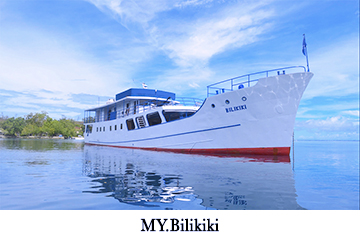 The Solomon Islands, where the Battle of Guadalcanal shifted the outcome of World War II, is a bucket-list dive destination. It's 17 hours from LAX, with a change of planes in Fiji. While the islands have a few small resorts, it's best dived from a liveaboard, and my choice was the venerable Bilikiki, 125 feet long and 25 feet wide, first deployed as a liveaboard in 1988. This was my fifth trip on the Bilikiki, and it was better than ever, with first-class service by a warm and competent 16-member crew. And the diving blew me away.
The Solomon Islands, where the Battle of Guadalcanal shifted the outcome of World War II, is a bucket-list dive destination. It's 17 hours from LAX, with a change of planes in Fiji. While the islands have a few small resorts, it's best dived from a liveaboard, and my choice was the venerable Bilikiki, 125 feet long and 25 feet wide, first deployed as a liveaboard in 1988. This was my fifth trip on the Bilikiki, and it was better than ever, with first-class service by a warm and competent 16-member crew. And the diving blew me away.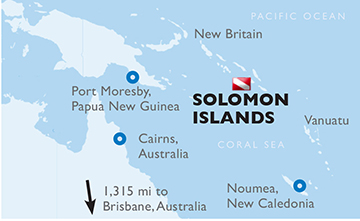 While we sometimes dived off the Bilikiki,
most of our diving was from aluminum boats - tinnies,
as they're called - each holding up to nine
divers. Before diving, I'd put my name tag on the
board to select my tinny (two left first, the third
a few minutes later). The crew hauled tanks to the
tinny and set them up. Just prior to the briefing,
after a manager had gone in to check conditions, we
learned topography, likely animals, and whether it
was a macro or wide-angle dive site. After a short
tinny ride, over backward we went. Upon surfacing, I
had my SMB ready, but my driver was always alongside
in a twinkling; only once did I need to inflate it
to get his attention. I'd hand up my weights and
BCD and climb the ladder. While it would seem impossible
for a tinny to leave behind one of six or
seven divers back on the Bilikiki, the crew checked
the board for tags to ensure no one was missing.
While we sometimes dived off the Bilikiki,
most of our diving was from aluminum boats - tinnies,
as they're called - each holding up to nine
divers. Before diving, I'd put my name tag on the
board to select my tinny (two left first, the third
a few minutes later). The crew hauled tanks to the
tinny and set them up. Just prior to the briefing,
after a manager had gone in to check conditions, we
learned topography, likely animals, and whether it
was a macro or wide-angle dive site. After a short
tinny ride, over backward we went. Upon surfacing, I
had my SMB ready, but my driver was always alongside
in a twinkling; only once did I need to inflate it
to get his attention. I'd hand up my weights and
BCD and climb the ladder. While it would seem impossible
for a tinny to leave behind one of six or
seven divers back on the Bilikiki, the crew checked
the board for tags to ensure no one was missing.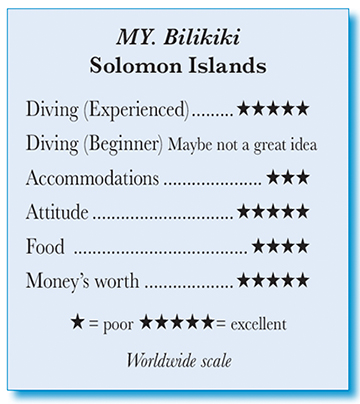 For me, history is a big part of the Bilikiki experience. I dived at four
WWII sites, two Japanese and two American: the Iwami Maru II, the Mavis Seaplane H6K5, PT Base 2, and White Beach. The Iwami Maru II, a cargo ship, was hit in December 1942 and sank upright on the sandy bottom 85 feet down. Low-vis gloom added to the eerie atmosphere. Sea fans the size of a diver and multicolored black corals covered the wreck's sides and deck, and the screws and rudder were festooned with soft corals. A beautiful ornate ghost pipefish, pale as a scrap of lace, hovered by a large deck cannon. Huge oysters clung onto chains; the anchors, still in their ports, were overgrown with hard corals. I am not a wreckhead, but this one was fascinating.
For me, history is a big part of the Bilikiki experience. I dived at four
WWII sites, two Japanese and two American: the Iwami Maru II, the Mavis Seaplane H6K5, PT Base 2, and White Beach. The Iwami Maru II, a cargo ship, was hit in December 1942 and sank upright on the sandy bottom 85 feet down. Low-vis gloom added to the eerie atmosphere. Sea fans the size of a diver and multicolored black corals covered the wreck's sides and deck, and the screws and rudder were festooned with soft corals. A beautiful ornate ghost pipefish, pale as a scrap of lace, hovered by a large deck cannon. Huge oysters clung onto chains; the anchors, still in their ports, were overgrown with hard corals. I am not a wreckhead, but this one was fascinating.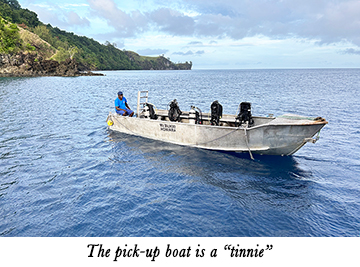 The Bilikiki's food is as good as possible in the Solomons, thanks to abundant local produce. The original managers of the boat, Maurine Shimlock and Burt Jones, brought villagers seeds to plant; so, at many islands, villagers paddle dugout canoes heaped with fresh fruits and veggies to sell the boat. I ate my fill of papaya and pineapple and loved the eggplant, squash, green beans, and tender lettuce provided at most meals. But the meat disappoints; the best the Bilikiki could offer was bone-in chicken (mostly wings), tough beef, and funky bacon. Fish, however, is fresh and tasty. My other quibble was breakfast, cooked in advance and on the table by 6 a.m., and by the time I got to breakfast most days, the scrambled eggs or omelets were cold. (I know, such a hardship.) After the first dive, baked treats like scones, shortbread, and chocolate chip cookies were laid out, popcorn in the afternoons, and a big tray of fresh fruit.
The Bilikiki's food is as good as possible in the Solomons, thanks to abundant local produce. The original managers of the boat, Maurine Shimlock and Burt Jones, brought villagers seeds to plant; so, at many islands, villagers paddle dugout canoes heaped with fresh fruits and veggies to sell the boat. I ate my fill of papaya and pineapple and loved the eggplant, squash, green beans, and tender lettuce provided at most meals. But the meat disappoints; the best the Bilikiki could offer was bone-in chicken (mostly wings), tough beef, and funky bacon. Fish, however, is fresh and tasty. My other quibble was breakfast, cooked in advance and on the table by 6 a.m., and by the time I got to breakfast most days, the scrambled eggs or omelets were cold. (I know, such a hardship.) After the first dive, baked treats like scones, shortbread, and chocolate chip cookies were laid out, popcorn in the afternoons, and a big tray of fresh fruit.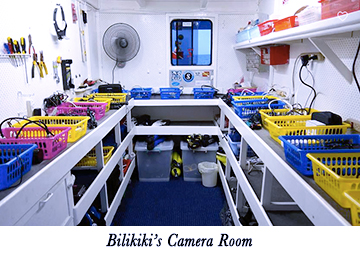 Maravaghi Bay, in the Floridas, is the only site where I saw my favorite anemonefish, the saddleback (Amphiprion polymnus), a badass fish with an outsized attitude. The manager's signal for it mimics kung fu! A small black female seahorse hung on gamely to bits in the sand, and Pato found a baby cockatoo waspfish half the size of my little pinky nail, as well as a minute shortpouch pygmy pipehorse with its tail wound around a sliver of seagrass. X-ray vision, Pato!
Maravaghi Bay, in the Floridas, is the only site where I saw my favorite anemonefish, the saddleback (Amphiprion polymnus), a badass fish with an outsized attitude. The manager's signal for it mimics kung fu! A small black female seahorse hung on gamely to bits in the sand, and Pato found a baby cockatoo waspfish half the size of my little pinky nail, as well as a minute shortpouch pygmy pipehorse with its tail wound around a sliver of seagrass. X-ray vision, Pato!
 Divers Compass: You can get to Honiara from Brisbane, Vanuatu, Fiji, and Port Moresby (PBG), all springboards to tourism or other diving . . . . Bilikiki trips vary by length; figure about $630 per night, double occupancy, more if you book a single . . . . Pre-water, coffees and teas and homemade limeade are for the asking. Sodas were $2, beer $4, a glass of wine $5, spirit shots $6; a bottle of good Australian chardonnay, sauvignon blanc, cabernet, merlot, or shiraz ran $20-25 . . . . Order rental in advance . . . . Bring cash to pay for carvings (I spent about $390 for 12 carvings) and tips, though tips can be put on a credit card . . . . . You are required to carry DAN or similar insurance . . . . . June-August is slightly cooler water (upper 77-81ºF) . . . . In Honiara, the Coral Sea Resort is a good choice for overnighting.
Divers Compass: You can get to Honiara from Brisbane, Vanuatu, Fiji, and Port Moresby (PBG), all springboards to tourism or other diving . . . . Bilikiki trips vary by length; figure about $630 per night, double occupancy, more if you book a single . . . . Pre-water, coffees and teas and homemade limeade are for the asking. Sodas were $2, beer $4, a glass of wine $5, spirit shots $6; a bottle of good Australian chardonnay, sauvignon blanc, cabernet, merlot, or shiraz ran $20-25 . . . . Order rental in advance . . . . Bring cash to pay for carvings (I spent about $390 for 12 carvings) and tips, though tips can be put on a credit card . . . . . You are required to carry DAN or similar insurance . . . . . June-August is slightly cooler water (upper 77-81ºF) . . . . In Honiara, the Coral Sea Resort is a good choice for overnighting.